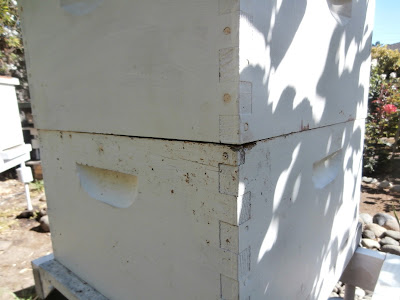As usual, a seeming simple task turned complicated. The added box did not fit snugly onto #3.
 |
| Large gap between boxes |
I gathered popsicle sticks, duct tape, box cutter (to shave shims) and a cinder block and returned to the hive. The box would rock, like a wobbly table, so I could not figure how a shim would help. I put the cinder block on and it made a significant but inadequate difference. So I scavenged more weight.
This brought the boxes together, and no need for duct tape. Of course, it will be added work when it comes time to go into this hive.
 |
| With weight on top |
I looked through the window and the combs around the MAQs were devoid of bees. I feared that the fumes were too strong due to insufficient ventilation, so I cracked open the top.
You can see the edges of the bars and spacers. There is a bit of a gap between the last bar and the back of the box.
The cluster has gone back into the hive, but the combs around the strips are still bee-less. That means that the brood on those combs has no nurse bees and is likely to die. Who knows what other damage was done? My intentions were good and perhaps things will turn out well. We will know in a month.



















